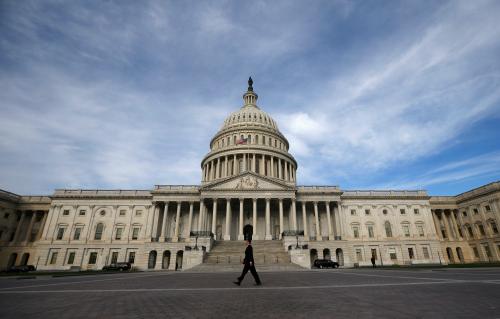This post answers common questions about the current version of the American Health Care Act (AHCA), which was passed by the House of Representatives on May 4, 2017. It is a follow-up to a similar piece published before the AHCA was passed by the House.
On May 4th, the House of Representatives passed the American Health Care Act (AHCA), complete with a series of amendments that represent compromises to gather enough votes. The majority of amendments centered around compromises to either relax federal requirements for the essential health benefits that were required in the Affordable Care Act as well as compromises to add more money to care for older patients or those with high risk medical conditions, since those patients are more likely to find insurance unaffordable due to changes allowing insurance companies to charge more for these patients. The Congressional Budget Office (CBO) released the estimated impact of the AHCA after the bill had already passed the House, finding that the bill would reduce access for 23 million Americans compared to the Affordable Care Act, largely through changes to the Medicaid program as well as issues of affordability and what is even considered to provide enough protection to count as insurance. While the Senate is working on their own bill that will likely look different than the one passed, Americans need to know how they may expect to be affected by this legislation. Here, we answer ten important questions about the legislation, its estimated impact, and what Americans can anticipate moving forward.
1. Does the American Health Care Act repeal the Affordable Care Act (ACA)?
The legislation does not repeal the ACA, but it does make significant changes to many ACA provisions, including the law’s Medicaid expansion, financial assistance for people purchasing individual market health insurance, regulations on health insurance plans in that market, and federal requirements that individuals have and employers offer health insurance. The law would also further limit federal funding for state Medicaid programs beyond rolling back funding for the ACA’s Medicaid expansion.
While earlier versions of the AHCA largely left insurance market regulations intact—including the requirement that insurers offer coverage to people with pre-existing conditions on the same terms as to everybody else—the AHCA bill passed by the House included new amendments that allow states to submit waivers to change some of the ACA’s consumer protections. For example, a state could waive the requirement that insurers must cover a minimum set of health benefits—such as hospital care, prescription drugs, and maternity care—or could waive the community rating requirement that prevents insurers from charging higher rates to individuals on the basis of health, gender, or other factors. The CBO projects that about one-sixth of the U.S. population lives in a state that would likely waive both essential health benefits and the community rating requirements.
However, some of the ACA’s insurance market regulations and its provisions affecting Medicare are generally not affected.
Notably, there is uncertainty as to whether the AHCA can be passed as intended through the Senate’s “budget reconciliation” process, which allows legislation to pass with fewer votes in the Senate but limits what types of changes that legislation can include. A full repeal would require a filibuster-proof 60 votes in the Senate, requiring at least eight Democrats to vote to fully repeal the ACA. Instead, the budget reconciliation process allows a bill to pass the Senate with only a simple majority, provided it is limited in scope to policies with a budgetary impact or are necessary to such budgetary provisions.
2. I currently purchase insurance on the individual market. What will the AHCA do to my insurance costs?
Under the ACA, the federal government provides advanced tax credits for premiums, called subsidies, which are determined by your income, age, and the cost of a silver-level insurance plan in your area and grow as the cost of insurance increases over time. They are available to people with incomes up to 400 percent of the federal poverty level (FPL), approximately $47,520 for a single individual or $97,200 for a family of four who are not offered employer coverage. For individuals with incomes between 100 and 250 percent FPL, the ACA also included cost-sharing subsidies to help with out-of-pocket costs. Under the AHCA, subsidies are determined by age and will grow with inflation, but do not vary based on income or on the cost of coverage in a person’s geographic area. These tax credits do phase out starting at income levels of $75,000, or $150,000 for a family. It also removes the extra cost sharing subsidies for those between 100 and 250 percent FPL.
The AHCA also includes changes that will affect premium costs. The CBO predicts that the Republican plan will cause a reduction in the generosity of coverage offered on the individual market, at least in some states, both by narrowing the types of benefits covered and by increasing cost sharing. The AHCA also includes other changes to insurance market regulations, such as loosening the age band by allowing insurers to charge five times as much for a 64-year-old compared to a 21-year-old, instead of three times as much, which is what the ACA dictates. This will lower premiums for younger individuals, and increase premiums for older enrollees.
The most recent MacArthur amendment would also allow states more flexibility to decide how to regulate insurance. If a state seeks a waiver, they can reduce the number of essential health benefits (EHBs) insurance companies must cover, which include things like hospital care, emergency services, mental health services, and maternity care, and insurers can charge more for consumers with pre-existing conditions. While insurers are theoretically only allowed to charge more to people who don’t maintain continuous coverage, this structure would in fact unravel protections for people with pre-existing conditions even if they did maintain continuous coverage.
What this all boils down to is that how much it costs to purchase coverage under the AHCA will vary widely depending on where you live, how old you are, and how much you earn. If you live in a state that chooses to take a waiver, having pre-existing conditions also affects your premium costs. The effects on consumers with pre-existing conditions is explained below.
In general, enrollees who are younger, have higher incomes, or live in low-cost areas are most likely to be better off, while enrollees who are older, have lower incomes, or live in high-cost areas are most likely to be worse off. In fact, the CBO’s latest report predicts that the out-of-pocket amount paid toward premiums by low-income, elderly enrollees could increase from $1,700 on average to $13,600 in states that only request a moderate amount of waivers, or $16,100 in states that request no waivers. On the other hand, 21 year olds with higher incomes would see premiums decrease from $5,100 on average to $1,250 in moderate waiver states, or $1,650 in non-waiver states. In the aggregate, subsidies will be lower.
To sum up: on average, premiums will be about four percent lower in non-waiver states by 2026, 20 percent in states that make moderate changes, and there would likely be even more of a significant decline in states that make a large amount of changes. However, this is mostly due to the fact that insurance won’t be as comprehensive in waiver states, and older, sicker populations will be priced out of the insurance market. Even if someone who is older and sicker can purchase a bare bones, low benefit plan, it will not likely protect them from financial devastation.
3. I have a preexisting condition: would this bill permit insurers to charge me more for my coverage, exclude coverage for my condition, or even deny me coverage?
It’s very possible. The AHCA bill that was passed in the House would allow insurers to charge higher amounts to individuals with pre-existing conditions if states sought a waiver to allow insurers in their state to do so. Under the revised bill, a state may apply for a waiver from the requirement that insurers charge individuals on the exchange the same price regardless of health status, which is often referred to as “community rating.” To be approved for the waiver, the state must demonstrate how it will achieve one of the following: reduce average premiums; increase enrollment; stabilize the individual market; or increase the choice of health plans.
States may receive waiver approval by premium reduction seemingly almost by default, as charging based on health status will likely price-out those with illness and leave a different pool of individuals, mostly healthy individuals, from which to calculate “average premiums.” Currently under the ACA, insurers set premiums based on an estimated average of health expenditures across the entire population. As a result, presently health people pay a higher premium than if they were charged based on their present health status, and people with a pre-existing condition pay a lower amount than if they were charged according to their present or historical health status. If this changed, and health insurers were able to charge based on health status, as House-approved bill outlines, premiums for the presently healthy would go down while premiums for those with illnesses would go up, in some cases dramatically so. Consequently, many people with illnesses or a history of disease may not choose, or be able to afford to, obtain coverage. With greater numbers of presently healthy individuals and fewer sick individuals enrolled in coverage, the average will be lower not by virtue of any improved competition or efficiency, but rather by who is and is not covered.
Additionally, a state may pursue a waiver from the ACA’s defined “essential health benefits” (EHB), allowing insurers to exclude certain types of care from coverage. In particular, the CBO report noted the following categories as likely being a target of EHB waivers: maternity care, mental health and substance abuse, rehabilitative and habilitative services, and pediatric dental care. If individuals wanted coverage for these services, they would come at additional costs above “essential” health coverage—if available at all.
There is debate over whether the Senate bill will include this ability to waive community rating or EHBs, and whether a bill with these changes could be passed as a budget reconciliation bill or if it would require 60 votes.
4. I have insurance through my employer. Am I affected by this?
It’s possible. Before the ACA, there were no legal protections from lifetime limits on insurance coverage. This meant that if an insurer decided to limit coverage to some maximum amount of money, it would stop providing any coverage for the beneficiaries who exceed this limit. Insurance companies also did not have to provide out of pocket spending limits, leaving a huge financial burden on patients who used very expensive care. The ACA changed this and included these protections for consumers. However, as our colleague Matthew Fiedler points out, these ACA protections are only for covering care that is considered an essential health benefit. Because the AHCA allows states the option to waive essential health benefits (EHBs), the ban on lifetime limits and maximum out-of-pocket spending limits may erode as EHBs are waived. For consumers who receive insurance through the individual or small group markets, their insurance companies have to follow its state’s requirement for EHBs. But large employers, which covered approximately 110 million people in 2015, don’t have to follow state rules – they can follow any state’s rule. So under current rules, if one state decides to waive all EHBs, a large employer operating in any state can choose to waive EHBs and accompanying protections and apply that to employees living in other states. The ACA protects against this currently by providing a federal baseline standard.
The AHCA also gets rid of the employer mandate, and the consequences of this are explained below.
5. I hear the AHCA gets rid of the mandates. Does this mean I would no longer be forced to buy insurance?
Yes. The AHCA would end the individual and employer mandates but introduces a continuous coverage provision. So while you would no longer be required to buy insurance, if you were uninsured for more than two months (technically 63 days) in the past year and then decide that you do want insurance, you would pay a penalty equal to 30 percent of your premium for one year. The thinking behind this is that people would stay insured to avoid the additional 30 percent penalties.
One worry is that healthy people would choose not to buy health insurance, knowing that they could obtain coverage later and pay only a modest surcharge. This would leave mostly sick people in the insurance pool. Without healthy low-cost people, premiums would increase to cover the disproportionate number of people with high medical costs. This would be exacerbated by an amendment reintroducing the use of medical underwriting for those without continuous coverage. States would be able to apply for and receive waivers to the community-rating rule and instead use health status to set premiums anyone without continuous health coverage. By removing community rating requirements, healthy people would have an incentive to go without coverage and reenter the market with lower premiums reflecting their health status, leaving only the sicker, higher-cost people in the community-rated pools. Premiums would continue to increase, eventually becoming unaffordable for the sickest populations
Another part of the AHCA removes penalties requiring employers to provide insurance to employees. In their original estimate, the CBO predicted that some employers would slowly stop offering coverage to their employees – partly because of this mandate removal, and partly because tax credits would be available to a broader range of incomes, making individual coverage more attractive to some employees. Employers with younger, higher-income employees would be most likely to stop offering employer coverage. Under the new estimate, the CBO estimates that fewer employers would stop offering coverage, particularly in waiver states, because insurance plans in the individual market would not be as attractive to their employees. To sum up, most changes in employer coverage will likely stem from changes in individual market regulations and subsidies, rather than the removal of the employer mandate.
6. Medicaid expansion was a large, controversial piece of the ACA. What happens next for states that did and didn’t expand?
The Medicaid program is a partnership between states and the federal government, with the federal government generally contributing between 50 and 75 percent of costs before the ACA, depending on state per capita income. To encourage states to expand Medicaid to more low-income adults up to 138 percent FPL, the federal government increased the federal share for this newly eligible population to 100 percent from 2014 to 2016, falling to a permanent 90 percent rate in 2020. The new GOP bill gets rid of this higher contribution and returns to each state’s original pre-ACA matching rate for new enrollees from this population that became eligible from the ACA. However, the Manager’s amendments released on March 20th allow work requirements for non-disabled adult enrollees, and encourages this by offering a five percent increase in matching funds if they do so. The amendment also restricts states from covering adults with incomes above 133 percent FPL after 2017, and states that have not already expanded cannot expand, effective as soon as the bill is passed.
Under the ACA, the CBO estimated that some additional states would expand Medicaid in the coming years, but without that enticing federal matching incentive, the CBO now estimates that AHCA will lead to 5 million fewer new expansion enrollees by 2026 compared to what they expect now. It’s also very likely that some states that have already expanded will revert to their pre-ACA Medicaid eligibility requirements, unable to bear these higher costs. Due largely to the reduction in states operating the ACA’s Medicaid expansion, the CBO estimates a 14 million decrease in Medicaid enrollment by 2026.
7. I keep hearing about per capita caps and block grants for Medicaid enrollees. How do these actually work, and what does this mean for costs?
Currently, Medicaid has open-ended funding, meaning that the federal government covers a certain percentage of whatever costs accrue, without limit. What the AHCA proposes is a dollar limit on spending from the federal government – a capped amount of money per enrollee, based on the current average cost in the state in 2016 for each category of enrollee (child, adult, disabled, and elderly). In the Manager’s amendments included on March 20th, the AHCA also allows states to accept block grants for a period of ten years for traditional enrollees (adults and children) instead of per capita allotments. The amount of the block grant is similar to per capita allotments – the per capita cost of this population is multiplied by the number of enrollees, with funding increasing by growth in the consumer price index, but not changes in population.
Both options leave little flexibility for states in cases of emergency, like outbreaks or natural disasters, or economic recessions, when spending can increase dramatically and unexpectedly or simply if health cost trends in their state diverge from the pre-specified rate at which the caps grow. So, while the CBO predicts that this will decrease federal spending, states must compensate by either increasing their contributions to Medicaid program costs spending through raising taxes orcutting other sectors of the state budget, or by reducing Medicaid spending through things like payment cuts for providers and health plans, getting rid of optional services for enrollees, or restricting enrollment eligibility. Block grants in particular encourage cuts to enrollment more than per capita allotments, since the total federal contribution does not change along with population increases or decreases, and this shifts the cost for care of this cut population to the states.
8. Is it true that Planned Parenthood would lose all of its government funding?
Under this proposed bill, Planned Parenthood would lose access to all federal funds for a year. If cut, this funding, which makes up around 43 percent of Planned Parenthood’s annual operating budget, would not only reduce access to care for the communities served, but also result in thousands of additional births. The CBO estimates that an additional $21 million would be spent for medical care for these additional pregnancies and births, particularly affecting low-income communities with limited health care provider access. Yes, defunding Planned Parenthood would save an estimated $156 million by 2026, but those living in low-income areas where Planned Parenthood is one of the only health care providers, would no longer have access to reproductive or general health care.
9. What exactly is the Prevention and Public Health Fund, and what is the bill proposing to do to its funding?
The Prevention and Public Health Fund was created under the ACA and is dedicated solely to expanding, improving, and sustaining public health and prevention programs. With these dollars, the Centers for Disease Control and Prevention (CDC) funds state and federal programs related to emergency disease outbreak response and preparedness, immunizations, the opioid crisis, life expectancy, and other public health issues affecting Americans. An analysis last month from the Trust for America’s Health (TFAH) estimates that the fund accounts for around 12 percent of the CDC’s annual budget. In fact, the Public Health Fund provides funding for almost half of the CDC’s immunization program budget, impacting its ability to track vaccinations and improve deadly infections.
The AHCA proposes to cut its funding entirely, which the TFAH analysis estimates could cost states over $3 billion over the next five years. This is especially alarming, as the CDC and public health departments are at the forefront when combating superbugs, infectious diseases, obesity and diabetes, bioterrorism, and other crucial public health crises. Taking away funding for these programs leaves Americans at greater risk from deadly infections and diseases and as former CDC director, Tom Frieden, said, could “[lead to] tens of thousands of additional illnesses and more than 10,000 additional deaths.”

10. I’m not yet 26 years old, would I be able to stay on my parents’ insurance if this bill is passed?
Yes, this bill leaves in place the ACA’s provision allowing young adults up to the age of 26 years to remain on their parents’ health insurance plan. The House had considered, but did not pass, an amendment to the bill that would have reduced the age limit to 23 years.











Commentary
10 questions Americans are—and should be—asking about the House-Passed AHCA and its projected impact
June 8, 2017